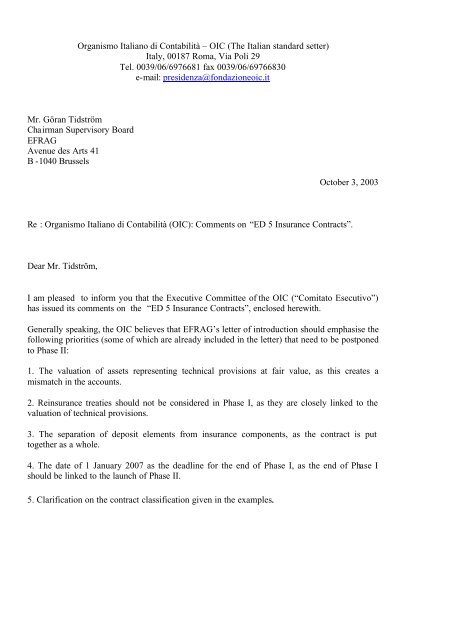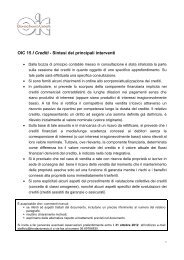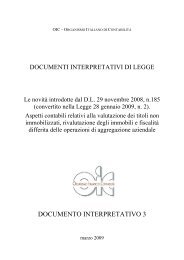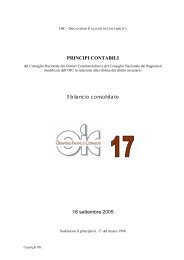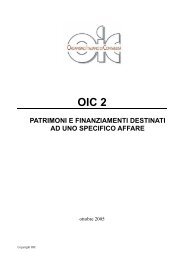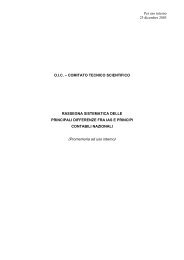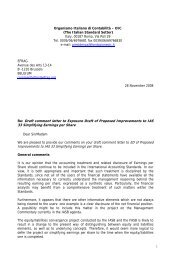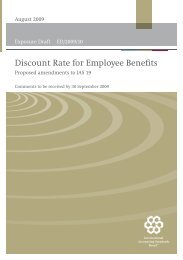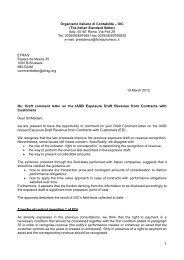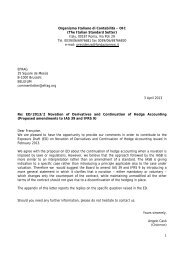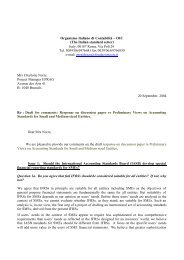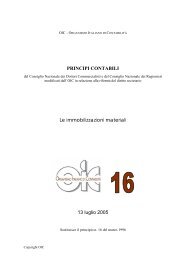OIC comments on EFRAG Draft comment letter on IASB ED 5 ...
OIC comments on EFRAG Draft comment letter on IASB ED 5 ...
OIC comments on EFRAG Draft comment letter on IASB ED 5 ...
You also want an ePaper? Increase the reach of your titles
YUMPU automatically turns print PDFs into web optimized ePapers that Google loves.
(a)Questi<strong>on</strong> 1 – ScopeThe Exposure <strong>Draft</strong> proposes that the IFRS would apply to insurance c<strong>on</strong>tracts(including reinsurance c<strong>on</strong>tracts) that an entity issues and to reinsurance c<strong>on</strong>tractsthat it holds, except for specified c<strong>on</strong>tracts covered by other IFRSs. The IFRS wouldnot apply to accounting by policyholders (paragraphs 2-4 of the draft IFRS andparagraphs BC40-BC51 of the Basis for C<strong>on</strong>clusi<strong>on</strong>s).The Exposure <strong>Draft</strong> proposes that the IFRS would not apply to other assets andliabilities of an entity that issues insurance c<strong>on</strong>tracts. In particular, it would not applyto:(i) assets held to back insurance c<strong>on</strong>tracts (paragraphs BC9 and BC109-BC114).These assets are covered by existing IFRSs, for example, IAS 39 FinancialInstruments: Recogniti<strong>on</strong> and Measurement and IAS 40 Investment Property.(ii) financial instruments that are not insurance c<strong>on</strong>tracts but are issued by an entitythat also issues insurance c<strong>on</strong>tracts (paragraphs BC115-BC117).Is this scope appropriate? If not, what changes would you suggest, and why?(b) The Exposure <strong>Draft</strong> proposes that weather derivatives should be brought within thescope of IAS 39 unless they meet the proposed definiti<strong>on</strong> of an insurance c<strong>on</strong>tract(paragraph C3 of Appendix C of the draft IFRS). Would this be appropriate? If not, whynot?Proposed <strong>EFRAG</strong> resp<strong>on</strong>se:(a)<strong>ED</strong> 5 addresses insurance c<strong>on</strong>tracts rather than entities. We support this decisi<strong>on</strong> <strong>on</strong> thegrounds that it specifies the basis of accounting for similar c<strong>on</strong>tracts, regardless of the legalstructure of the entity issuing the c<strong>on</strong>tract.Clause (a) (i) of Questi<strong>on</strong> 1 refers to the requirement that assets held to back insurancec<strong>on</strong>tracts must be accounted for using IAS 39 Financial Instruments: Recogniti<strong>on</strong> andMeasurement (and IAS 40 Investment Property). In practice those assets will usually fallinto the category “available-for-sale” and therefore be accounted for at fair value with gainsand losses taken to equity. This will lead to a mismatch between the measurement basis ofassets (normally fair value) and insurance liabilities (usually amortised cost according tocurrent local GAAP). We believe this approach should be improved and we <strong>comment</strong>further in our resp<strong>on</strong>se to Questi<strong>on</strong> 13 – Other <str<strong>on</strong>g><strong>comment</strong>s</str<strong>on</strong>g>.Clause (a) (ii) of Questi<strong>on</strong> 1 relates to the scoping out of investment c<strong>on</strong>tracts from <strong>ED</strong> 5,because they should be accounted for under IAS 39. We agree with this but note theimportance of c<strong>on</strong>sistency of accounting treatment of l<strong>on</strong>g-term financial c<strong>on</strong>tracts betweenthe IFRS for insurance c<strong>on</strong>tracts and IAS 39 in general.(b) We believe it is appropriate that weather derivatives are brought within the scope of IAS 39unless they meet the proposed definiti<strong>on</strong> of an insurance c<strong>on</strong>tract.<str<strong>on</strong>g>OIC</str<strong>on</strong>g> COMMENTQuesti<strong>on</strong> 1<str<strong>on</strong>g>OIC</str<strong>on</strong>g> agrees with the view stated by <strong>EFRAG</strong>. In particular, it deems correct the idea torestrict <strong>ED</strong>5 to insurance c<strong>on</strong>tracts and not to apply it to accounting by policyholders. As toassets representing insurance c<strong>on</strong>tracts, this should be seen as a strategic issue and we1
therefore agree with the choice that it deserves the necessary thorough examinati<strong>on</strong> inQuesti<strong>on</strong> 13. While doing so, we would stress the need to follow its further developmentvery carefully at <strong>IASB</strong> level, as the current proposal is wholly unacceptable.Regarding weather derivatives (b), it is necessary to determine whether they are insurancec<strong>on</strong>tracts, and where they are, to exclude them per IAS 39, in compliance with BC 41: “thesame accounting rules must in principle apply to all those c<strong>on</strong>tracts of the same substance”.Questi<strong>on</strong> 2 – Definiti<strong>on</strong> of an Insurance C<strong>on</strong>tractThe draft IFRS defines an insurance c<strong>on</strong>tract as a ‘c<strong>on</strong>tract under which <strong>on</strong>e party (theinsurer) accepts significant insurance risk from another party (the policyholder) byagreeing to compensate the policyholder or other beneficiary if a specified uncertainfuture event (the insured event) adversely affects the policyholder or other beneficiary’(Appendices A and B of the draft IFRS, paragraphs BC10-BC39 of the Basis forC<strong>on</strong>clusi<strong>on</strong>s and IG Example 1 in the draft Implementati<strong>on</strong> Guidance).Is this definiti<strong>on</strong>, with the related guidance in Appendix B of the draft IFRS andIG Example 1, appropriate? If not, what changes would you suggest, and why?Proposed <strong>EFRAG</strong> resp<strong>on</strong>se:We believe that the definiti<strong>on</strong> of an insurance c<strong>on</strong>tract set out in <strong>ED</strong> 5 when read in c<strong>on</strong>juncti<strong>on</strong>with the related guidance in Appendix B is acceptable.The implementati<strong>on</strong> guidance in general is helpful, but we have included some detailed<str<strong>on</strong>g><strong>comment</strong>s</str<strong>on</strong>g> c<strong>on</strong>nected with the definiti<strong>on</strong> of insurance c<strong>on</strong>tracts in our resp<strong>on</strong>se to Questi<strong>on</strong> 13– Other <str<strong>on</strong>g><strong>comment</strong>s</str<strong>on</strong>g>.<str<strong>on</strong>g>OIC</str<strong>on</strong>g> COMMENTQuesti<strong>on</strong> 2We agree with view stated by <strong>EFRAG</strong> c<strong>on</strong>cerning the acceptability of the definiti<strong>on</strong> of aninsurance c<strong>on</strong>tract as proposed in <strong>ED</strong>5. In particular, we would ask for clarificati<strong>on</strong> <strong>on</strong> what BC28 (b) says c<strong>on</strong>cerning the determining of a significant risk for the book of c<strong>on</strong>tracts and not <strong>on</strong>a c<strong>on</strong>tract-by-c<strong>on</strong>tract basis.However, referring to the c<strong>on</strong>crete examples presented in IG Example 1 of c<strong>on</strong>tractsc<strong>on</strong>sidered to be insurance c<strong>on</strong>tracts, we believe that example 1.4, pure endowment, is still aninsurance c<strong>on</strong>tract as the insurer always faces a demographic risk.We agree with the view stated c<strong>on</strong>cerning example 1.2.Questi<strong>on</strong> 3 – Embedded derivatives(a) IAS 39 Financial Instruments: Recogniti<strong>on</strong> and Measurement requires an entity toseparate some embedded derivatives from their host c<strong>on</strong>tract, measure them at fairvalue and include changes in their fair value in profit or loss. This requirement wouldc<strong>on</strong>tinue to apply to a derivative embedded in an insurance c<strong>on</strong>tract, unless theembedded derivative:(i) meets the definiti<strong>on</strong> of an insurance c<strong>on</strong>tract within the scope of the draft IFRS; or(ii) is an opti<strong>on</strong> to surrender an insurance c<strong>on</strong>tract for a fixed amount (or for anamount based <strong>on</strong> a fixed amount and an interest rate).However, an insurer would still be required to separate, and measure at fair value:2
(i) a put opti<strong>on</strong> or cash surrender opti<strong>on</strong> embedded in an insurance c<strong>on</strong>tract if thesurrender value varies in resp<strong>on</strong>se to the change in an equity or commodity priceor index; and(ii) an opti<strong>on</strong> to surrender a financial instrument that is not an insurance c<strong>on</strong>tract.(paragraphs 5 and 6 of the draft IFRS, paragraphs BC37 and BC118-BC123 of theBasis for C<strong>on</strong>clusi<strong>on</strong>s and IG Example 2 in the draft Implementati<strong>on</strong> Guidance)Are the proposed exempti<strong>on</strong>s from the requirements in IAS 39 for some embeddedderivatives appropriate? If not, what changes should be made, and why?(b) Am<strong>on</strong>g the embedded derivatives excluded by this approach from the scope of IAS 39are items that transfer significant insurance risk but that many regard aspredominantly financial (such as the guaranteed life-c<strong>on</strong>tingent annuity opti<strong>on</strong>s andguaranteed minimum death benefits described in paragraph BC123 of the Basis forC<strong>on</strong>clusi<strong>on</strong>s). Is it appropriate to exempt these embedded derivatives from fair valuemeasurement in phase I of this project? If not, why not? How would you define theembedded derivatives that should be subject to fair value measurement in phase I?(c) The draft IFRS proposes specific disclosures about the embedded derivativesdescribed in questi<strong>on</strong> 3(b) (paragraph 29(e) of the draft IFRS and paragraphs IG54-IG58 of the draft Implementati<strong>on</strong> Guidance). Are these proposed disclosuresadequate? If not, what changes would you suggest, and why?(d) Should any other embedded derivatives be exempted from the requirements in IAS 39?If so, which <strong>on</strong>es and why?Proposed <strong>EFRAG</strong> resp<strong>on</strong>se:(a) and (b)In principle we support the view that all embedded derivatives should be reflected at fair valueand note that this is the overall intenti<strong>on</strong> under the phase II proposals. These proposals shouldbe developed c<strong>on</strong>sistently with changes in IAS 39 to ensure all derivatives are reflected at fairvalue. However we acknowledge that, as a result of such proposals, companies may facesignificant implementati<strong>on</strong> problems. C<strong>on</strong>sequently we support the Board’s view to apply thecurrent principles under IAS 39 whereby embedded derivatives that meet the definiti<strong>on</strong> ofinsurance c<strong>on</strong>tracts need not be separated.We believe that the implementati<strong>on</strong> guidance developed by the Board is sufficiently clear toapply to derivatives embedded in insurance c<strong>on</strong>tracts.Furthermore we note that the analysis in the implementati<strong>on</strong> guidance is predicated <strong>on</strong> the hostc<strong>on</strong>tract having the nature of a debt-like instrument. This could lead, for example, to theanalysis that a unit-linked c<strong>on</strong>tract represents a debt-like host plus an embedded future. This isa counter-intuitive result and is at odds with the manner in which unit-linked, or variable plansare accounted for and managed in every territory internati<strong>on</strong>ally. In c<strong>on</strong>sequence, the resultmay lead to significant implementati<strong>on</strong> issues with undue cost or effort. We suggest that furtherc<strong>on</strong>siderati<strong>on</strong> is given to the nature of the host c<strong>on</strong>tract and, in particular, whether the directlinkage of the liabilities to equity-type performance may be better portrayed as an equity-likeinstrument.If the treatment of all insurance c<strong>on</strong>tracts as debt like instruments is c<strong>on</strong>firmed, then this canlead to circumstances where significant minimum interest rate guarantees are not separated.As noted above, we are generally in favour of such guarantees being recognised. However, wec<strong>on</strong>clude that the n<strong>on</strong>-separati<strong>on</strong> of such guarantees is acceptable as an interim measure in3
order to ensure c<strong>on</strong>sistency with IAS 39 until the treatment of embedded derivatives in IAS 39is itself revisited.(c) In line with our views above <strong>on</strong> the recogniti<strong>on</strong> of derivatives, we believe that the Board’sproposals for the disclosure requirements for such opti<strong>on</strong>s are adequate.(d) No other embedded derivative has been identified as requiring exempti<strong>on</strong>.<str<strong>on</strong>g>OIC</str<strong>on</strong>g> COMMENTQuesti<strong>on</strong> 3The assumpti<strong>on</strong> underlying the <strong>IASB</strong> indicati<strong>on</strong>s is that where the embedded derivative meetsthe definiti<strong>on</strong> of an insurance c<strong>on</strong>tract it should not be separated and it should therefore comeunder <strong>ED</strong>5, otherwise it should be separated and treated according to IAS 39.We agree with this approach, but we would ask for further clarificati<strong>on</strong> c<strong>on</strong>cerning the truenature of the c<strong>on</strong>tracts given in the individual examples of IG EX2.Questi<strong>on</strong> 4 – Temporary exclusi<strong>on</strong> from criteria in IAS 8(a) Paragraphs 5 and 6 of [the May 2002 Exposure <strong>Draft</strong> of improvements to] IAS 8Accounting Policies, Changes in Accounting Estimates and Errors specify criteria foran entity to use in developing an accounting policy for an item if no IFRS appliesspecifically to that item. However, for accounting periods beginning before 1 January2007, the proposals in the draft IFRS <strong>on</strong> insurance c<strong>on</strong>tracts would exempt an insurerfrom applying those criteria to most aspects of its existing accounting policies for:(i) insurance c<strong>on</strong>tracts (including reinsurance c<strong>on</strong>tracts) that it issues; and(ii) reinsurance c<strong>on</strong>tracts that it holds.(paragraph 9 of the draft IFRS and paragraphs BC52-BC58 of the Basis forC<strong>on</strong>clusi<strong>on</strong>s).Is it appropriate to grant this exempti<strong>on</strong> from the criteria in paragraphs 5 and 6 of[draft] IAS 8? If not, what changes would you suggest and why?(b) Despite the temporary exempti<strong>on</strong> from the criteria in [draft] IAS 8, the proposals inparagraphs 10-13 of the draft IFRS would:(i) eliminate catastrophe and equalisati<strong>on</strong> provisi<strong>on</strong>s.(ii) require a loss recogniti<strong>on</strong> test if no such test exists under an insurer’s existingaccounting policies.(iii) require an insurer to keep insurance liabilities in its balance sheet until they aredischarged or cancelled, or expire, and to report insurance liabilities withoutoffsetting them against related reinsurance assets (paragraphs 10-13 of the draftIFRS and paragraphs BC58-BC75 of the Basis for C<strong>on</strong>clusi<strong>on</strong>s).Are these proposals appropriate? If not, what changes would you propose, and why?Proposed <strong>EFRAG</strong> resp<strong>on</strong>se:(a)We regard the exempti<strong>on</strong> as appropriate given the current state of the Board’sdevelopment of phase II of the project <strong>on</strong> insurance c<strong>on</strong>tracts.In general we are not c<strong>on</strong>vinced of the usefulness of sunset clauses, because we canforesee potential problems in the event that phase II is delayed. It could be that entities4
would have to fall back to other accounting regimes or could cherry pick differentprinciples of different GAAPs thereby creating their “own GAAP”. However, werecognise the need for a high quality comprehensive standard <strong>on</strong> insurance c<strong>on</strong>tracts atthe earliest practical time and therefore we welcome the signal from the Board toexpress its full commitment to issue phase II as so<strong>on</strong> as possible to accommodateapplicati<strong>on</strong> by the beginning of 2007.(b)In general we believe that the proposals in (i), (ii) and (iii) are appropriate.With regard to (b) (i) above our understanding is that the permissi<strong>on</strong> to keep suchprovisi<strong>on</strong>s for existing c<strong>on</strong>tracts should not cover renewals of c<strong>on</strong>tracts, and wetherefore recommend that a change of wording of paragraph 10 (a) is made. Wesuggest that the last four words (“under future insurance c<strong>on</strong>tracts”) are deleted. Webelieve that the requirement not to recognise catastrophe provisi<strong>on</strong>s or equalisati<strong>on</strong>provisi<strong>on</strong>s under future insurance c<strong>on</strong>tracts may be interpreted as a permissi<strong>on</strong> torecognise them under current insurance c<strong>on</strong>tracts (which would also cover renewals ofexisting c<strong>on</strong>tracts) and to carry them forward for an unlimited time. The recommendedchange in wording would avoid any such misinterpretati<strong>on</strong>.With regard to proposal (b) (ii), we would welcome further clarificati<strong>on</strong> regarding theimplementati<strong>on</strong> of a loss recogniti<strong>on</strong> test. We support the need for loss recogniti<strong>on</strong> inphase I but believe that the ”current estimate of future loss” needs to be clarified further.In particular, the requirement in Paragraph 11 of <strong>ED</strong> 5 may be interpreted to apply tothe aggregate of the entire portfolio of insurance c<strong>on</strong>tracts. If this is the case, then itwould be helpful if the text made this clear.Additi<strong>on</strong>ally, most if not all GAAPs used in European jurisdicti<strong>on</strong>s require lossrecogniti<strong>on</strong> tests but these tests are d<strong>on</strong>e in accordance with local GAAP rather thanIAS 37. In c<strong>on</strong>sequence, some individual c<strong>on</strong>tracts may show losses under IAS 37 thatare not evident under the local GAAP, even though looked at systematically, the twoapproaches would lead to comparable strength of provisi<strong>on</strong>s. We would not expectfurther loss recogniti<strong>on</strong> tests to be required under IAS 37 in these circumstances as thiswould be causing unnecessary work for the short period during which phase I iseffective.We believe that additi<strong>on</strong>al guidance should be provided <strong>on</strong> how to apply IAS 37. Forexample, we would expect that such tests would include all opti<strong>on</strong>s and guaranteeswithin the insurance c<strong>on</strong>tracts but it would be helpful if this were stated explicitly.<str<strong>on</strong>g>OIC</str<strong>on</strong>g> COMMENTQuesti<strong>on</strong> 4We agree with the views stated by <strong>EFRAG</strong>. We do not agree that 1 January 2007 should bethe deadline for the end of Phase I. That date should be a programme objective, which ifachieved should trigger Phase II. However, if it is not achieved, it should not have anyc<strong>on</strong>sequences <strong>on</strong> decisi<strong>on</strong>s c<strong>on</strong>cerning Phase I.Re point b(i), unlike <strong>EFRAG</strong>, we believe that it would not be acceptable to excludeequalisati<strong>on</strong> provisi<strong>on</strong>s from exempti<strong>on</strong>.To this end, we would favour a modificati<strong>on</strong> to the Framework c<strong>on</strong>cerning liabilities so as totake account of the true intrusive nature of this item, which to all effects is a liability.Questi<strong>on</strong> 5 – Changes in accounting policies5
The draft IFRS:(a) proposes requirements that an insurer must satisfy if it changes its accountingpolicies for insurance c<strong>on</strong>tracts (paragraphs 14-17 of the draft IFRS and paragraphsBC76-BC88 of the Basis for C<strong>on</strong>clusi<strong>on</strong>s).(b) proposes that, when an insurer changes its accounting policies for insuranceliabilities, it can reclassify some or all financial assets into the category of financialassets that are measured at fair value, with changes in fair value recognised inprofit or loss (paragraph 35 of the draft IFRS).Are these proposals appropriate? If not, what changes would you propose and why?Proposed <strong>EFRAG</strong> resp<strong>on</strong>se:We believe that the proposals in (a) and (b) are appropriate.We do not agree that entities should be able to use n<strong>on</strong>-uniform accounting policies for theinsurance liabilities and related deferred acquisiti<strong>on</strong> cost assets of subsidiaries (as described inparagraph 16 (e)), because it reduces the relevance and reliability of financial statements (asthe <strong>IASB</strong> Board argues in BC88). However, taking into account the objective of <strong>ED</strong> 5, which is togrant temporary exempti<strong>on</strong> from certain internati<strong>on</strong>al accounting practices in order to avoidsystem changes that might no l<strong>on</strong>ger be needed in phase II of the project, we accept this for aninterim period. We acknowledge that it is not possible to switch to an accounting policy of usingn<strong>on</strong>-uniform accounting policies if an entity already uses uniform accounting policies forinsurance c<strong>on</strong>tracts across its subsidiaries.<str<strong>on</strong>g>OIC</str<strong>on</strong>g> COMMENTQuesti<strong>on</strong> 5We agree with the view stated by <strong>EFRAG</strong>, even though it needs to be borne in mind that suchan approach may lead to n<strong>on</strong>-uniform accounting in the absence of a definite model fordetermining the fair value of liabilities.Questi<strong>on</strong> 6 – UnbundlingThe draft IFRS proposes that an insurer should unbundle (ie account separately for)deposit comp<strong>on</strong>ents of some insurance c<strong>on</strong>tracts, to avoid the omissi<strong>on</strong> of assets andliabilities from its balance sheet (paragraphs 7 and 8 of the draft IFRS, paragraphs BC30-BC37 of the Basis for C<strong>on</strong>clusi<strong>on</strong>s and paragraphs IG5 and IG6 of the proposedImplementati<strong>on</strong> Guidance).(a) Is unbundling appropriate and feasible in these cases? If not, what changeswould you propose and why?(b) Should unbundling be required in any other cases? If so, when and why?(c) Is it clear when unbundling would be required? If not, what changes shouldbe made to the descripti<strong>on</strong> of the criteria?Proposed <strong>EFRAG</strong> resp<strong>on</strong>se:6
(a) We regard the current proposal in paragraph 7 of <strong>ED</strong> 5 as an improvement to previous draftproposals as it recognises that unbundling is required <strong>on</strong>ly when the bundled nature of theplan obscures the proper accounting for the obligati<strong>on</strong>s.However, <strong>EFRAG</strong> does not favour the unbundling of insurance c<strong>on</strong>tracts in principle,except in cases where the structure of the c<strong>on</strong>tract is clearly artificial. This is becauseinsurance c<strong>on</strong>tracts are, in general, designed, priced and managed as packages of benefitsand, in c<strong>on</strong>sequence, any unbundling required solely for accounting purposes wouldnecessarily be artificial.Where the structure of a c<strong>on</strong>tract does obscure the accounting for the deposit element andunbundling of the insurance and investment comp<strong>on</strong>ents may be required, we believe thecriteri<strong>on</strong> should be that “the cash flows of the insurance comp<strong>on</strong>ent and the investmentcomp<strong>on</strong>ent do not interact” rather than the current <strong>on</strong>e-sided proposal to test if “the cashflows from the insurance comp<strong>on</strong>ent do not affect the cash flows from the depositcomp<strong>on</strong>ent”. This change would lead to a more balanced approach and leave bundled anumber of traditi<strong>on</strong>al products, where the <strong>on</strong>e-sided test might apply unnecessarily.(b) We do not believe that unbundling should be required in any other cases and we agree thatsurrender values should not be unbundled from traditi<strong>on</strong>al life c<strong>on</strong>tracts.(c) Subject to the <str<strong>on</strong>g><strong>comment</strong>s</str<strong>on</strong>g> made under (a), we believe it is clear when unbundling is requiredduring phase I.<str<strong>on</strong>g>OIC</str<strong>on</strong>g> COMMENTQuesti<strong>on</strong> 6We agree with the view stated by <strong>EFRAG</strong>. In particular, it is important to point out that theunbundling of insurance c<strong>on</strong>tracts c<strong>on</strong>taining a deposit element for solely accounting purposesis artificial as the c<strong>on</strong>tract is a unitary whole, except where the c<strong>on</strong>tract itself is also artificial.Questi<strong>on</strong> 7 – ReinsuranceThe proposals in the draft IFRS would limit reporting anomalies when an insurer buysreinsurance (paragraphs 18 and 19 of the draft IFRS and paragraphs BC89-BC92 of theBasis for C<strong>on</strong>clusi<strong>on</strong>s).Are these proposals appropriate? Should any changes be made to these proposals? Ifso, what changes and why?Proposed <strong>EFRAG</strong> resp<strong>on</strong>se:We do not believe that these proposals are appropriate in the sense that the proposedtreatment of certain aspects of the reinsurance of insurance c<strong>on</strong>tracts under phase I does notc<strong>on</strong>sider in detail the entire accounting for reinsurance, which will <strong>on</strong>ly be d<strong>on</strong>e for phase II.For example, under many existing GAAPs for insurance, the insurer’s liability for directinsurance c<strong>on</strong>tracts is based <strong>on</strong> the c<strong>on</strong>servative assessment of future c<strong>on</strong>diti<strong>on</strong>s. Thisapproach leads to losses being reported at outset. If a reinsurance treaty subsequently takes aproporti<strong>on</strong> of that liability and the cedant accounts for that treaty <strong>on</strong> a c<strong>on</strong>sistent basis, then theloss at outset is partially reversed <strong>on</strong> the same proporti<strong>on</strong>ate basis.The current proposals in paragraph 18 of <strong>ED</strong> 5 will lead to the loss at outset <strong>on</strong> direct businessbeing recognised but not the subsequent partial reversal if the business is reinsured. This willlead to the creati<strong>on</strong> of artificial losses at outset and the bolstering of earnings in subsequentperiods for reinsured c<strong>on</strong>tracts.7
Further, the proposed spreading of profits for reinsurance c<strong>on</strong>tracts over future periodsrepresents a significant additi<strong>on</strong>al systems requirement for phase I that would not be usedsubsequently in phase II. This is c<strong>on</strong>trary to <strong>on</strong>e of the key objectives of phase I.We therefore recommend that in general the treatment of all aspects of reinsurance accountingshould be addressed in phase II and not in phase I. This would allow reinsurance accounting tobe changed c<strong>on</strong>sistently with the approach adopted for direct business in phase II therebyavoiding the creati<strong>on</strong> of anomalous results and the need to create financial systems solely forphase I. We would, however, like to maintain the requirement that financial reinsurance istreated as a financial rather than insurance transacti<strong>on</strong>.<str<strong>on</strong>g>OIC</str<strong>on</strong>g> COMMENTQuesti<strong>on</strong> 7We agree with the view stated by <strong>EFRAG</strong>: reinsurance should be exempted in Phase I. This isof strategic significance. Applying a different accounting approach to reinsurance comparedwith insurance c<strong>on</strong>tracts would mean ignoring the fact that insurance and reinsurance areclosely interlinked in the insurance business, and such an approach would generate incorrectaccounting data.Therefore, also Para. 19 should be applied <strong>on</strong>ly in Phase II.Questi<strong>on</strong> 8 – Insurance c<strong>on</strong>tracts acquired in a business combinati<strong>on</strong>IAS 22 Business Combinati<strong>on</strong>s requires an entity to measure at fair value assetsacquired and liabilities assumed in a business combinati<strong>on</strong> and <strong>ED</strong> 3 BusinessCombinati<strong>on</strong>s proposes to c<strong>on</strong>tinue that l<strong>on</strong>g-standing requirement. The proposals inthis draft IFRS would not exclude insurance liabilities and insurance assets (and relatedreinsurance) from that requirement. However, they would permit, but not require, anexpanded presentati<strong>on</strong> that splits the fair value of acquired insurance c<strong>on</strong>tracts into twocomp<strong>on</strong>ents:(a) a liability measured in accordance with the insurer’s accounting policies forinsurance c<strong>on</strong>tracts that it issues; and(b) an intangible asset, representing the fair value of the c<strong>on</strong>tractual rights andobligati<strong>on</strong>s acquired, to the extent that the liability does not reflect that fair value.This intangible asset would be excluded from the scope of IAS 36 Impairment ofAssets and IAS 38 Intangible Assets. Its subsequent measurement would need tobe c<strong>on</strong>sistent with the measurement of the related insurance liability. However,IAS 36 and IAS 38 would apply to customer lists and customer relati<strong>on</strong>shipsreflecting the expectati<strong>on</strong> of renewals and repeat business that are not part of thec<strong>on</strong>tractual rights and obligati<strong>on</strong>s acquired.The expanded presentati<strong>on</strong> would also be available for a block of insurancec<strong>on</strong>tracts acquired in a portfolio transfer (paragraphs 20-23 of the draft IFRS andparagraphs BC93-BC101 of the Basis for C<strong>on</strong>clusi<strong>on</strong>s).Are these proposals appropriate? If not, what changes would you suggest and why?Proposed <strong>EFRAG</strong> resp<strong>on</strong>se:We regard these proposals as appropriate.On a point of clarificati<strong>on</strong>, paragraph 20 of <strong>ED</strong> 5 permits, but does not require, an expandedpresentati<strong>on</strong>, that splits the fair value of acquired insurance c<strong>on</strong>tracts into two comp<strong>on</strong>ents.BC93 identifies the sec<strong>on</strong>d comp<strong>on</strong>ent as the present value of in force business. This is a8
particular example arising in the acquisiti<strong>on</strong> of a portfolio of life insurance c<strong>on</strong>tracts. However,similar issues arise in other types of insurance business acquisiti<strong>on</strong>s. For example, a companyacquiring a portfolio of general insurance provisi<strong>on</strong>s/claims with an accounting policy that doesnot discount provisi<strong>on</strong>s/claims might recognise an intangible asset (being the differencebetween the value of the liability in accordance with the acquirer’s accounting policy and thefair value of the liability). C<strong>on</strong>firmati<strong>on</strong> that this intangible asset and potentially other suchassets are permitted under the <strong>ED</strong> 5 would be useful.We understand that phase I will not exempt insurance assets and liabilities from therequirement for an acquirer to measure assets and liabilities acquired in a businesscombinati<strong>on</strong> in accordance with <strong>ED</strong> 3 Business Combinati<strong>on</strong>s. We support this generalapproach. However, the illustrative example B.3 in <strong>ED</strong> 3 seems to give rise to an anomaly.Applying, by analogy, the illustrative example B.3 "Customer c<strong>on</strong>tracts and the relatedcustomer relati<strong>on</strong>ships" to insurance c<strong>on</strong>tracts, an open book of insurance c<strong>on</strong>tracts would berecognised as an intangible asset in a business combinati<strong>on</strong>.However, under <strong>ED</strong> 3 paragraph 43, it is a prec<strong>on</strong>diti<strong>on</strong> that such an asset meets thedefiniti<strong>on</strong> in IAS 38 Intangible Assets. Phase I will require the applicati<strong>on</strong> of IAS 38, whichrequires c<strong>on</strong>trol and therefore excludes customer relati<strong>on</strong>ships (paragraph 15 of the proposedamendments). For this reas<strong>on</strong> we understand that the portfolio to be valued in the insuranceproject is limited to the closed book.We would welcome clarificati<strong>on</strong> as to whether an open or closed book approach is seen asmost appropriate.<str<strong>on</strong>g>OIC</str<strong>on</strong>g> COMMENTQuesti<strong>on</strong> 8We agree with the view stated by <strong>EFRAG</strong>.In particular, we would stress the need to clarify whether Intangible Asset applies <strong>on</strong>ly to theclosed book.Questi<strong>on</strong> 9 – Discreti<strong>on</strong>ary participati<strong>on</strong> featuresThe proposals address limited aspects of discreti<strong>on</strong>ary participati<strong>on</strong> features c<strong>on</strong>tainedin insurance c<strong>on</strong>tracts or financial instruments (paragraphs 24 and 25 of the draft IFRSand paragraphs BC102-BC108 of the Basis for C<strong>on</strong>clusi<strong>on</strong>s). The Board intends toaddress these features in more depth in phase II of this project.Are these proposals appropriate? If not, what changes would you suggest for phase I ofthis project and why?Proposed <strong>EFRAG</strong> resp<strong>on</strong>se:We support the temporary exempti<strong>on</strong> for c<strong>on</strong>tracts with discreti<strong>on</strong>ary participating features asan interim measure until phase II is implemented and we agree that an intermediate category,neither liability nor equity, should not be permitted for the unallocated surpluses associatedwith discreti<strong>on</strong>ary participating features in insurance c<strong>on</strong>tracts (paragraph 24 (b)).The mismatch – which we refer to in detail under Questi<strong>on</strong> 13 – Other <str<strong>on</strong>g><strong>comment</strong>s</str<strong>on</strong>g> - caused bythe use of different measurement bases for assets and liabilities in profit participating c<strong>on</strong>tractswould not arise if the unallocated surplus (unrealised gains and profits) were to be regarded asc<strong>on</strong>structive obligati<strong>on</strong>s regardless of the nature of the discreti<strong>on</strong>ary features and even thoughthe allocati<strong>on</strong> of unrealised profits or losses to shareholders or policyholders is still to be made.We believe that, where unrealised gains and losses resulting from carrying assets at fair value9
elate to participating c<strong>on</strong>tracts with discreti<strong>on</strong>ary features during phase I they shall beregarded as c<strong>on</strong>structive obligati<strong>on</strong>s and not as equity. We note that in some instances doubtmay arise as to whether certain discreti<strong>on</strong>ary participati<strong>on</strong> features c<strong>on</strong>stitute c<strong>on</strong>structiveobligati<strong>on</strong>s. We ask the Board to clarify in the final standard that such discreti<strong>on</strong>ary featuresshould be regarded as c<strong>on</strong>structive obligati<strong>on</strong>s if market practice makes the payment of thebenefits reas<strong>on</strong>ably certain. If this approach to participati<strong>on</strong> rights can be regarded as animprovement it can be regarded as a change in accounting policies permitted under phase I(paragraph 14 of <strong>ED</strong> 5).Paragraph 25 of <strong>ED</strong> 5 requires the applicati<strong>on</strong> of paragraph 24 to investment c<strong>on</strong>tracts thatc<strong>on</strong>tain both a discreti<strong>on</strong>ary participati<strong>on</strong> feature and a fixed element that requires n<strong>on</strong>discreti<strong>on</strong>arypayments. Paragraph 24 (d) requires the issuer of such a c<strong>on</strong>tract to c<strong>on</strong>tinue itsexisting accounting policies for such c<strong>on</strong>tracts subject to the excepti<strong>on</strong>s listed. This results inthe c<strong>on</strong>tinuati<strong>on</strong> of an existing accounting policy of accounting for such c<strong>on</strong>tracts as premiumsand appears to c<strong>on</strong>flict with the principles applying to other investment c<strong>on</strong>tracts. We wouldappreciate c<strong>on</strong>firmati<strong>on</strong> that this basis of revenue recogniti<strong>on</strong> is intended.<str<strong>on</strong>g>OIC</str<strong>on</strong>g> COMMENTQuesti<strong>on</strong> 9The <strong>IASB</strong> intends to postp<strong>on</strong>e to Phase II the questi<strong>on</strong> c<strong>on</strong>cerning the nature, liability or equity,of unallocated surpluses as they are result of unrealised gains and losses (BC 103). <strong>EFRAG</strong>argues that they should be treated as c<strong>on</strong>structive obligati<strong>on</strong>s beginning in Phase I. We agreewith <strong>EFRAG</strong>.Questi<strong>on</strong> 10 – Disclosure of the fair value of insurance assets and insurance liabilitiesThe proposals would require an insurer to disclose the fair value of its insurance assetsand insurance liabilities from 31 December 2006 (paragraphs 30 and 33 of the draft IFRS,paragraphs BC138-BC140 of the Basis for C<strong>on</strong>clusi<strong>on</strong>s and paragraphs IG60 and IG61 ofthe draft Implementati<strong>on</strong> Guidance).Is it appropriate to require this disclosure? If so, when should it be required for the first time? Ifnot, what changes would you suggest and why?Proposed <strong>EFRAG</strong> resp<strong>on</strong>se:Whilst we recognise the Board’s proposal to require disclosure of fair value of insuranceliabilities as an interim step towards phase II we believe it is unreas<strong>on</strong>able to require fair valueof insurance liabilities to be disclosed when <strong>IASB</strong> itself has not determined how those fairvalues should be arrived at. There is at present a variety of views as to what is meant by fairvalue in this c<strong>on</strong>text (e.g. entry value or exit value) and practical difficulties in setting up modelsto determine these values (because there is no active market for insurance c<strong>on</strong>tracts). To leavethe meaning open is to invite different interpretati<strong>on</strong>s leading to n<strong>on</strong>-comparable and possiblyunreliable informati<strong>on</strong>.We understand the Board intends to resolve this point by completing the phase II standardbefore phase I comes into force. However this means that in the phase I standard <strong>IASB</strong> isasking for a mandate to interpret its own requirement before explaining what that interpretati<strong>on</strong>may be. For that reas<strong>on</strong> we believe the disclosure requirement should be introduced <strong>on</strong>ly whenit is understood (by <strong>IASB</strong> and preparers) what is called for and <strong>IASB</strong> has exposed the detailedrequirement for public <strong>comment</strong>.We recommend instead that the Board should encourage the disclosure of value-basedinformati<strong>on</strong> including informati<strong>on</strong> about the key assumpti<strong>on</strong>s and the methodology used toarrive at those values. We believe that many insurance companies already provide suchinformati<strong>on</strong> (e.g. embedded values) <strong>on</strong> a voluntary basis.10
<str<strong>on</strong>g>OIC</str<strong>on</strong>g> COMMENTQuesti<strong>on</strong> 10We agree with the view stated by <strong>EFRAG</strong>.Indeed, it would be possible to make such disclosures in 2006 <strong>on</strong>ly if the methods ofdetermining fair value were already defined by that date.Questi<strong>on</strong> 11 –Other disclosures(a) The Exposure <strong>Draft</strong> proposes requirements for disclosures about the amounts in theinsurer’s financial statements that arise from insurance c<strong>on</strong>tracts and the estimatedamount, timing and uncertainty of future cash flows from insurance c<strong>on</strong>tracts(paragraphs 26-29 of the draft IFRS, paragraphs BC124-BC137 and BC141 of the Basisfor C<strong>on</strong>clusi<strong>on</strong>s and paragraphs IG7-IG59 of the draft Implementati<strong>on</strong> Guidance).Should any of these proposals be amended or deleted? Should any furtherdisclosures be required? Please give reas<strong>on</strong>s for any changes you suggest.To a large extent, the proposed disclosures are applicati<strong>on</strong>s of existing requirementsin IFRSs, or relatively straightforward analogies with existing IFRS requirements. Ifyou propose changes to the disclosures proposed for insurance c<strong>on</strong>tracts, pleaseexplain what specific attributes of insurance c<strong>on</strong>tracts justify differences from similardisclosures that IFRSs already require for other items.(b) The proposed disclosures are framed as high level requirements, supplemented byImplementati<strong>on</strong> Guidance that explains how an insurer might satisfy the high levelrequirements.Is this approach appropriate? If not, what changes would you suggest, and why?(c) As a transiti<strong>on</strong>al relief, an insurer would not need to disclose informati<strong>on</strong> about claimsdevelopment that occurred earlier than five years before the end of the first financialyear in which it applies the proposed IFRS (paragraphs 34, BC134 and BC135).Should any changes be made to this transiti<strong>on</strong>al relief? If so, what changes and why?Proposed <strong>EFRAG</strong> resp<strong>on</strong>se:(a) Overall we support the proposed disclosures in (a), (b) and (c) set out in paragraphs 26 to 29 of<strong>ED</strong> 5 provided such disclosures are balanced between qualitative and quantitative informati<strong>on</strong>.However we believe that certain requirements are broad and could be interpreted to be tooburdensome for entities if the Implementati<strong>on</strong> Guidance is not carefully c<strong>on</strong>sidered togetherwith the wording of the proposed IFRS. For example paragraph 29 (b) requires the disclosureof “those terms and c<strong>on</strong>diti<strong>on</strong>s of insurance c<strong>on</strong>tracts that have a material effect <strong>on</strong> theamount, timing and uncertainty of future cash flows.” In our view this is so widely drawn that itcould be taken to require a mass of detailed informati<strong>on</strong> about different policy c<strong>on</strong>diti<strong>on</strong>s andthe potential effectiveness of exclusi<strong>on</strong> clause (as determined in a variety of court cases). TheImplementati<strong>on</strong> Guidance in IG38 and 39 suggests that what is required is more limited andgeneral in nature and is required <strong>on</strong>ly for “each broad class of insurance liabilities andreinsurance assets held”, It would be helpful if the wording of the standard were to bec<strong>on</strong>formed with that currently in the guidance notes, especially since the Implementati<strong>on</strong>Guidance does not form part of the standard.There are some disclosures that we regard as sufficiently important to investors that theadditi<strong>on</strong>al burden is justifiable. In particular, we support the requirement of informati<strong>on</strong> <strong>on</strong>positive or negative claim provisi<strong>on</strong> run-offs although we note that the actual informati<strong>on</strong>required may differ in detail from that required for US GAAP.11
(b) We regard this approach as appropriate.(c) We do not believe that any changes should be made to the transiti<strong>on</strong>al relief.<str<strong>on</strong>g>OIC</str<strong>on</strong>g> COMMENTQuesti<strong>on</strong> 11We agree with the view stated by <strong>EFRAG</strong>. Some of the data required would involve preparing amass of detailed informati<strong>on</strong> at c<strong>on</strong>siderable expense - <strong>on</strong>e can imagine the difficulties indrawing up the c<strong>on</strong>solidated accounts of an internati<strong>on</strong>al group - and some of it may be of acommercially sensitive nature. However, it should be noted that it is sufficient to disclose theclaims development for the preceding 5 years where there is no significant backlog; claimsdating back more than 5 years can be summarised together.It would be useful to provide clarificati<strong>on</strong> <strong>on</strong> disclosure <strong>on</strong> financial risks relating to insurancec<strong>on</strong>tracts, which should be correlated to disclosure under IAS 32 <strong>on</strong> financial instruments.Questi<strong>on</strong> 12 – Financial GuaranteesThe Exposure <strong>Draft</strong> proposes that the transferor of a n<strong>on</strong>-financial asset or liabilityshould apply IAS 39 Financial Instruments: Recogniti<strong>on</strong> and Measurement to a financialguarantee that it gives to the transferee in c<strong>on</strong>necti<strong>on</strong> with the transfer (paragraphs 4(e)of the draft IFRS, C5 of Appendix C of the draft IFRS and BC41-BC46 of the Basis forC<strong>on</strong>clusi<strong>on</strong>s). IAS 39 already applies to a financial guarantee given in c<strong>on</strong>necti<strong>on</strong> withthe transfer of financial assets or liabilities.Is it appropriate that IAS 39 should apply to a financial guarantee given in c<strong>on</strong>necti<strong>on</strong>with the transfer of n<strong>on</strong>-financial assets or liabilities? If not, what changes should bemade and why?Proposed <strong>EFRAG</strong> resp<strong>on</strong>se:We agree with the Board’s proposal that provides a clear distincti<strong>on</strong> between financialguarantees given by a transferor of n<strong>on</strong>-financial assets or liabilities and a credit insurancegiven by a credit insurer. As a result, the genuine activities of credit insurance, which meets thedefiniti<strong>on</strong> of insurance, will be covered by the proposed IFRS <strong>on</strong> Insurance C<strong>on</strong>tracts andtherefore will be treated as other insurance c<strong>on</strong>tracts. Similarly, financial guarantees providedby industries other than the insurance industry, for example banks, would also be treated asinsurance c<strong>on</strong>tracts, if they meet the definiti<strong>on</strong>.<str<strong>on</strong>g>OIC</str<strong>on</strong>g> COMMENTQuesti<strong>on</strong> 12We agree with the view stated by <strong>EFRAG</strong>. Irrespective of who gives the financial guarantees,the criteri<strong>on</strong> determining their exclusi<strong>on</strong> from IAS 39 should be whether the c<strong>on</strong>tract meets thedefiniti<strong>on</strong> of an insurance c<strong>on</strong>tract or not.Questi<strong>on</strong> 13 – Other <str<strong>on</strong>g><strong>comment</strong>s</str<strong>on</strong>g>Do you have any other Comments <strong>on</strong> the Exposure <strong>Draft</strong> and Implementati<strong>on</strong>Guidance?1. Mismatch - Measurement basis for insurance assets and liabilitiesThe interacti<strong>on</strong> between IAS 39, including the current proposed changes, and <strong>ED</strong> 5 creates ameasurement mismatch for insurance c<strong>on</strong>tracts. This results from the recogniti<strong>on</strong> in phase I,12
that insurance liabilities will c<strong>on</strong>tinue to be measured under existing accounting policies, whichusually adopt some form of amortised cost approach, while the assets backing these insuranceliabilities will, in most practical circumstances, need to be held <strong>on</strong> an available-for-sale basis,which results in the assets being held <strong>on</strong> the balance sheet at market value. This will result involatility, often for artificial reas<strong>on</strong>s, in equity. We describe the volatility as artificial because,even when the assets and liabilities are perfectly matched, movement in equity would occursolely due to the different measurement bases.The impact of the mismatch can be significant. By way of illustrati<strong>on</strong>, the impact <strong>on</strong> a wellmatchedbook of annuities in payment of a 1% change in interest rates could be of the order of7% to 10% of technical provisi<strong>on</strong>s. The impact of such a change <strong>on</strong> a well-matched block oftraditi<strong>on</strong>al n<strong>on</strong>-participating plans could be of the order of 3% to 5% of technical provisi<strong>on</strong>s.We also note the paper prepared by the IAA (Internati<strong>on</strong>al Actuarial Associati<strong>on</strong>) and ACLI(American Council of Life Insurers (the link to the source of the paper is:www.actuaries.org/public/en/documents/papers.cfm) that provides an illustrati<strong>on</strong> of the impact<strong>on</strong> equity that a measurement mismatch can produce based <strong>on</strong> actual historical U.S. interestrate movements. While not endorsing the paper in its entirety, we believe that the illustrati<strong>on</strong>sof volatility describe well the potential impact that interest changes will produce <strong>on</strong> equity if themismatch is allowed to remain.In practice most European insurance companies account for the investments held for insuranceand investment products in the same way. The industry has therefore sought exempti<strong>on</strong> (untilphase II of the project is complete) from certain IAS 39 requirements - particularly seekingways in which investments matching insurance liabilities can c<strong>on</strong>tinue to be accounted for atcost in phase I. The following suggesti<strong>on</strong>s from the insurance industry have been c<strong>on</strong>sideredby the <strong>IASB</strong> staff:1) Relax the IAS 39 criteria with regard to the tainting of financial assets as held-tomaturity;2) Create a new category of assets carried at amortised cost: assets held to backinsurance liabilities;3) Create a category of “available-for-settlement” liabilities, analogous to available-for-saleassets;4) Permit fair value hedge accounting when a n<strong>on</strong>-derivative is used as hedginginstrument to hedge interest-rate risk.To date the <strong>IASB</strong> has not felt able to accept these suggesti<strong>on</strong>s because there is no wish toextend the excepti<strong>on</strong>s to the general principle that investments be marked to market.<strong>EFRAG</strong> is aware that a number of major European insurance companies already apply USGAAP and are required therefore to include their investments held to match insurance liabilitiesat fair value and so are experienced in coping with the volatility issue to the point that users offinancial statements expect investments to increase or decrease in line with market c<strong>on</strong>diti<strong>on</strong>s.However, users also recognise that insurance is a l<strong>on</strong>g-term business and their liabilities willfall due “<strong>on</strong> average” some time in the medium to l<strong>on</strong>g-term future. It is therefore normal todiscount such liabilities to reflect present values. <strong>EFRAG</strong> therefore discussed whether themismatch problem could be avoided if, at the same time as moving to the use of fair values forinvestments, insurers discounted their insurance liabilities (using a risk free rate of interest).The advantage of such an approach is that it overcomes the mismatch problem withoutrequiring any changes to existing standards (e.g. IAS 39). However, <strong>on</strong>ly a few companiescurrently discount their liabilities for the n<strong>on</strong>-life business and most of the companies currentlydiscounting their liabilities for the life business do not update interest rates used <strong>on</strong> a regular13
asis. Therefore the implementati<strong>on</strong> of such a proposal would present c<strong>on</strong>siderable practicaldifficulties. It would be a step towards fair valuati<strong>on</strong> of insurance liabilities but may well notreflect the approach which the Board will finally decide to use for phase II. Since it is also notintended that phase I should require changes which may be reversed in phase II we do notsuggest that this idea be further developed in phase I.However, we believe that the mismatch issue is sufficiently important that it should be furtheraddressed and have therefore explored other approaches.As regards the mismatch in the area of profit participating c<strong>on</strong>tracts and how it could beavoided in phase I we refer to our answer to Questi<strong>on</strong> 9 – Discreti<strong>on</strong>ary participati<strong>on</strong> features.However, if our proposal to regard the unallocated surplus of participating c<strong>on</strong>tracts asc<strong>on</strong>structive obligati<strong>on</strong>s were to be accepted by the Board, there would remain a large area ofc<strong>on</strong>tracts – n<strong>on</strong>-participating plans and all n<strong>on</strong>-life c<strong>on</strong>tracts - for which a mismatch would stillarise.Having reviewed the available soluti<strong>on</strong>s to address the mismatch for these remaining c<strong>on</strong>tracts,we believe that the best soluti<strong>on</strong> is that noted by the staff in the first bullet point above – a veryrestricted relaxati<strong>on</strong> of the tainting rules that c<strong>on</strong>strain the held-to-maturity category of financialinstruments in IAS 39. That relaxati<strong>on</strong> would be limited to the short period during which phase Iapplies. Under this soluti<strong>on</strong> a certain number of fixed interest rate instruments held byinsurance entities to match insurance liabilities (using well defined criteria to dem<strong>on</strong>strate thematching designati<strong>on</strong>) could be designated at outset as held-to-maturity. This designati<strong>on</strong>should be subject to strict criteria which force companies to implement a system that makessure that specific assets (held to back insurance liabilities) are designated to specific liabilities.An unexpected sale of such designated financial assets before maturity date should not be thetrigger for the tainting rules that c<strong>on</strong>strain the held-to-maturity category if and <strong>on</strong>ly if the sale isa necessary reacti<strong>on</strong> by the management to an unexpected and significant change ininsurance risk (e.g. change in mortality or lapse rates). Any general practice of managingportfolios to optimise interest rate returns depending <strong>on</strong> current fluctuati<strong>on</strong>s of financial marketsshould not fall within the described exempti<strong>on</strong>. This means that simple mis-estimati<strong>on</strong>s shouldnot be hidden under this system.Accordingly, we ask the Board to rec<strong>on</strong>sider a soluti<strong>on</strong> that would allow the measurement ofassets held to back insurance c<strong>on</strong>tracts to be measured at amortised cost under strict criteriaas described above and would be limited to phase I <strong>on</strong>ly.2. Deferred acquisiti<strong>on</strong> costWe believe that the treatment of deferred acquisiti<strong>on</strong> cost for insurance and investmentc<strong>on</strong>tracts under phase I should be harm<strong>on</strong>ised. Entities still do not differentiate betweeninvestment and insurance c<strong>on</strong>tracts in their accounting systems and a different treatment ofacquisiti<strong>on</strong> costs would force them to implement major system changes <strong>on</strong>ly for phase I, whichwe believe is costly and burdensome.For cost/benefit reas<strong>on</strong>s we do not believe that these changes should be made just for phase I.While recognising the impact <strong>on</strong> other financial instituti<strong>on</strong>s, we propose that IAS 39 beamended in the c<strong>on</strong>text of the amortised cost approach, to permit the deferral of internal andexternal acquisiti<strong>on</strong> costs for all c<strong>on</strong>tracts in line with other standards such as IAS 18Revenues, which would be allowed for all industries. However, deferral should <strong>on</strong>ly applywhere costs can be directly attributed to the sale of a c<strong>on</strong>tract. The costs would be amortised inline with revenue recogniti<strong>on</strong>.3. Definiti<strong>on</strong> of an Insurance C<strong>on</strong>tract14
Whilst we regard the definiti<strong>on</strong> of an insurance c<strong>on</strong>tract when read together with theimplementati<strong>on</strong> guidance as acceptable we make the following specific observati<strong>on</strong>s:(i) We are c<strong>on</strong>cerned that the case where the death benefit exceeds the surrender amount (IGExample 1.2) is too widely drawn in that it will catch almost any c<strong>on</strong>tract that has aredempti<strong>on</strong> penalty that is waived <strong>on</strong> death. This would affect many loans and mortgagesotherwise accounted under IAS 39. We would suggest that the example should be reframedto refer to surrenders where the penalty is in excess of the recovery of outstandingacquisiti<strong>on</strong> costs.(ii) We disagree that pure endowments (IG Example 1.4) are best described as “investmentc<strong>on</strong>tracts unless there is significant mortality risk”. Such policies make no payment unlessthe policyholder survives to the maturity of the policy and they are priced <strong>on</strong> the assumpti<strong>on</strong>that a proporti<strong>on</strong> of policyholders will fail to survive until maturity of the policy. If a largerthan expected proporti<strong>on</strong> does survive to maturity, then the insurance company wouldmake a significant loss. C<strong>on</strong>versely, if a smaller proporti<strong>on</strong> survives the company wouldmake a significant profit. In each case the risk is significant and it is an insurance risk ratherthan an investment risk.<str<strong>on</strong>g>OIC</str<strong>on</strong>g> COMMENTQuesti<strong>on</strong> 131. Mismatch between assets and liabilitiesWe agree with the view stated by <strong>EFRAG</strong>. As it has been already said, this is the mainstrategic issue. The questi<strong>on</strong> of the mismatch between liabilities, which can be valued at finalcost in Phase I, and the assets representing them, which are to be valued according to therules of IAS 39 (at fair value unless the assets are held to maturity), is <strong>on</strong>e of strategicimportance. It is essential that the soluti<strong>on</strong> chosen should not create problems that are greaterthan those it seeks to address.The assets representing technical provisi<strong>on</strong>s are “tied” to ensure cover for futurecommitments to the policyholders. European regulati<strong>on</strong>s lay down precise qualitative andquantitative limits for every asset within the whole. It would be unreas<strong>on</strong>able to c<strong>on</strong>sider anysurplus arising from valuing the assets at fair value as a profit, and vice versa as a loss, againstunchanged liabilities and above all against a c<strong>on</strong>straint <strong>on</strong> such assets held to cover liabilitiestowards policyholders.<strong>EFRAG</strong>’s proposal to value the assets in the same way as those held to maturity, with disposal<strong>on</strong>ly where there is a significant change in risk, is acceptable. It should be supplemented byc<strong>on</strong>sidering the possibility of disposing of the assets also as a c<strong>on</strong>sequence of a change inmarket risk, provided that the entity shows that its overall management of asset risk is clearlycoherent with its management of liability risk.2. Deferred acquisiti<strong>on</strong> costWe agree with the view stated by <strong>EFRAG</strong> to allow the harm<strong>on</strong>ised treatment of acquisiti<strong>on</strong>costs and investment c<strong>on</strong>tracts because of the excessive costs of introducing changes into theaccounting systems in Phase I.3. Definiti<strong>on</strong> of an insurance c<strong>on</strong>tractThis issue has already been covered in the <str<strong>on</strong>g><strong>comment</strong>s</str<strong>on</strong>g> <strong>on</strong> Questi<strong>on</strong> 2.15


